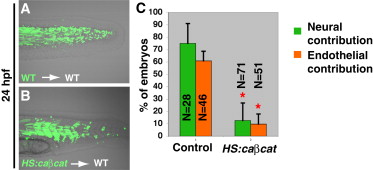Fig. 6
Wnt Signaling Is Sufficient to Specify Paraxial Mesoderm in Multipotent Stem Cells (A and B) Fluorescein labeled wild-type or HS:caβcat cells were heat-shocked and then transplanted into the ventral margin of shield stage unlabeled wild-type embryos. (A) In control transplants, the majority of cells contribute to the posterior somites, but a small number also contribute to the posterior spinal cord. (B) In transplants with activated Wnt signaling, cells contribute to somites but not spinal cord. (C) Host embryos containing transplanted cells with activated Wnt signaling have a significantly reduced likelihood of cells contributing to neural or endothelial fates (as determined by transplanting fli1:GFP or fli1:GFP/HS:caβcat), compared with controls (p < 0.05 indicated by red asterisk). See also Figure S2.
Reprinted from Developmental Cell, 22(1), Martin, B.L., and Kimelman, D., Canonical Wnt Signaling Dynamically Controls Multiple Stem Cell Fate Decisions during Vertebrate Body Formation, 223-232, Copyright (2012) with permission from Elsevier. Full text @ Dev. Cell

